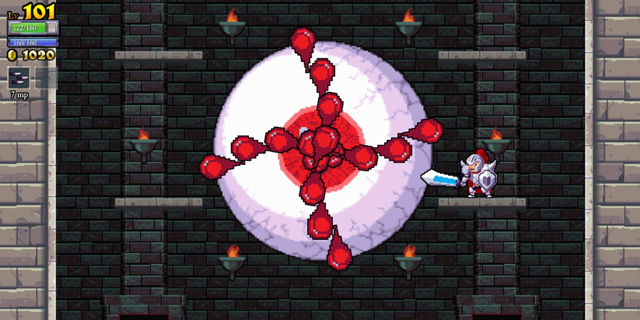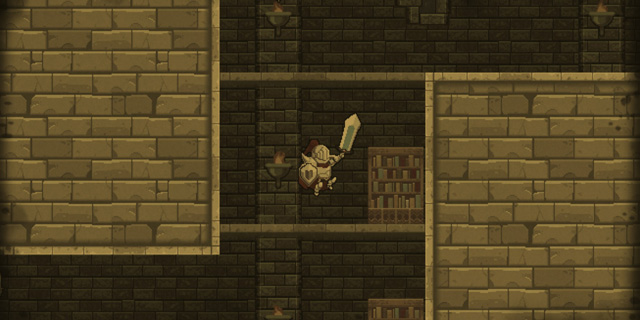
Dextrocardia: a condition where the heart is located on the right side of the chest instead of the left. For most of us, that’s just a bit of trivia. For the one in 12,000 affected by the condition, it’s significantly more than that. Other conditions related to dextrocardia can be fatal if unchecked and unmanaged. In Rogue Legacy, though, all it means is that your HP and MP pools are swapped.
It’s also probably not the only affliction a given character has. My most recent run had me running through NG+3 with a Spelunker (complete with trusty headlamp for illuminating dark areas in the dungeon) who suffered from dyslexia, copralalia and baldness. Oh, and she was a lady, so the baldness was especially embarrassing. It’s much easier for a male character to channel Jean-Luc Picard and go on killing monsters.
The character system makes Rogue Legacy special. No two runs are the same, because of the number of different character builds available to the player. I went four runs in a row in my first game wanting to try to tackle the third boss, but ended up looking for additional gold because all of my available heirs were various flavors of mages (I prefer physical attack to magic) and miners (decreased attack, increased gold find). The game influenced my decision to improve my characters by obtaining more gold to improve my castle and buy better gear.

In most games, buying new equipment is a big part of the level-up experience. In Rogue Legacy, it’s the only part. There are no experience points, and there are no loot drops. If you’re going to improve, then you’re going to spend. And you are incentivized to spend, as money does not carry over from one playthrough to the next. When a character dies — and they will — his or her eventual heir inherits the cash found in the castle, and must spend as much of it as possible before going in themselves because Charon guards the entrance and won’t step aside until you surrender your gold to him.
Improving the castle unlocks new classes, improves already-unlocked classes and improves your whole family’s base stats like health, mana, magic attack and critical hit chance. Spending money at the blacksmith gets you new equipment usable by all family members, and spending money at the enchantress gets you new abilities and modification by way of runes. My usual load-out for runes granted me a double-jump, a dash and 30% extra gold. It let me stay mobile and made every character pick up as much gold as a miner without the hit to my attack strength. It also made miners amazing, since they were picking up 60% extra instead of 30%. The level displayed on the HUD is directly related to the amount of gold spent: killing skeletons and slimes is satisfying and sometimes nets you some pocket money, but you’ll never see a level-up screen after taking out a baddie.

Aesthetically, Rogue Legacy is my new favorite SNES game. In terms of difficulty, it’s my new favorite SNES game. Rogue Legacy is Nintendo hard. You’ll die. After that you’ll die again. And after that you’ll die again. Then you’ll have enough money for the Vault rune (double jump) and will try the first boss yet again and this time he’ll go down. And then you’re hooked. I won’t lie to you: the combat is hard.
You’ve got to be paying attention. You’ll slash at an enemy, and need to know that it’ll die in one hit. Why? If you leave that eye monster alone, it’ll shoot projectiles out that your Barbarian King with his gigantism could never dodge. You’ll be jumping and slashing your sword all over the place, searching the castle for fairy chests for more runes to slot into equipment. You’ll get to a point when chests are disappointing if they have money in them, because what you’re after is blueprints to buy new and better gear from the blacksmith.
The mechanics are tight, and the gameplay is fair. Every time I failed to kill a boss, every time I slipped and fell on some spikes and every time I got cocky and ran into an enemy who wasn’t quite dead, it was my fault, not the game’s. That’s a big part of what keeps me coming back to Rogue Legacy: it’s challenging without being mean. Every enemy has a pattern, every chest can be reached with the right combination of runes and magic, and every run (assuming I play well enough) lets me give the next guy a little leg up on his journey. Sir Dude IV, the dyslexic, giant Barbarian King, didn’t make it, but his daughter Lady Charlotte the dwarven Shinobi with Peripheral Arterial Disease (no foot pulse means no setting off spike traps), ADHD (destroying things yields mana) and a brand new sword and chestplate? She just might.
Pros: Constant sense of progression, rewarding combat and platforming, fun randomly-generated characters
Cons: It’s possible to upgrade in such a way that progress is difficult



















